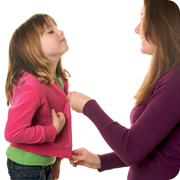
Milestones ahead

During the transition from toddlers to childhood, there's lots of growth to look forward to, and lots of key milestones along the way. Make sure you have your camera ready, because they grow up fast.
By age 6, your child will most likely be able to:

With heightened depth perception comes more developed motor skills. Expect your child to become more coordinated on his feet as he jumps, runs and hops. With practice, hand-eye coordination will improve to make buttoning a jacket and zipping pants possible.
To help develop motor skills, have your child:
By age 5 or 6, your child will most likely have the needed motor skills and depth perception to tie their shoelaces.
Here are some suggestions to get them started:

By age 4 your child should be able to brush her teeth on her own, although supervision is still recommended.
It is also recommended that you:
The general rule is that the earlier your child's teeth come in, the sooner they fall out. If teething began early, the first tooth or two could be lost before kindergarten.
A few tips to keep in mind:

Between ages 3 to 5 a preschooler can go from knowing 900 words to 2,500 to 3,000 words.
Here are some ways to help build your child's vocabulary:
Reading with your child can speed their learning. By reading together, your child learns:
Like any skill, reading is something children learn at their own pace. Making reading fun and stress-free will help your child develop a love of books.